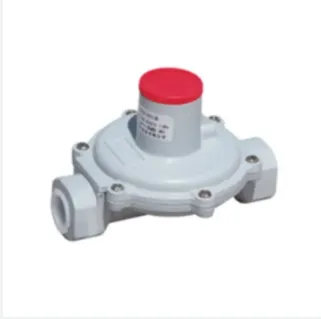
Feb . 26, 2025 14:57
Back to list
Optimizing Energy Systems with Advanced Equipment
In modern energy systems, equipment like heat exchangers, pressure regulators, pressure reducing valves, natural gas pressure regulators, and gasification equipment play an essential role in optimizing performance, ensuring efficiency, and maintaining safety. These components are crucial in industries ranging from power generation to manufacturing, where precise control of energy processes is required. This article explores how each piece of equipment contributes to a more efficient, safe, and sustainable operation.

Heat Exchanger: Key to Efficient Energy Transfer
A heat exchanger is a device that facilitates the transfer of heat between two or more fluids. These are commonly used in power plants, HVAC systems, and chemical processing industries. The role of a heat exchanger is crucial in improving energy efficiency by recovering and reusing heat from one fluid and transferring it to another, without the fluids mixing.
In power plants, heat exchangers are used to transfer the heat from combustion gases to water, which is then turned into steam for turbines. This process allows for greater energy efficiency, as it reduces the need for additional fuel. In HVAC systems, heat exchangers are responsible for heating or cooling air, thereby regulating building temperatures. By implementing high-efficiency heat exchangers, industries can save on fuel costs, reduce carbon emissions, and improve the overall energy output of systems.
Pressure Regulators: Ensuring Safe and Efficient Operation
A pressure regulator is a critical component used to control and maintain the pressure of gases and liquids within a desired range. These regulators are used in a variety of applications, including natural gas pipelines, chemical plants, and industrial processes. The primary function of a pressure regulator is to reduce high input pressures to a lower, consistent output pressure, ensuring that the systems operate within the required limits.
For instance, in natural gas systems, a pressure regulator ensures that the gas entering the pipeline is at a safe pressure before it is distributed. Without a pressure regulator, fluctuations in pressure could lead to gas leaks, accidents, or inefficient system operation. By regulating the pressure, the pressure regulator ensures that systems are operating at maximum efficiency and safety, reducing the likelihood of hazardous conditions.
Pressure Reducing Valve: Maintaining Stability in Systems
A pressure reducing valve is another vital component in maintaining pressure control. It’s used to reduce and stabilize the pressure in various systems, such as in water systems, steam systems, and fuel lines. While pressure regulators are typically used for gas applications, the pressure reducing valve is designed to handle both liquid and gas systems, helping to ensure that the system operates safely under optimal pressure conditions.
For example, in industrial boilers, a pressure reducing valve is crucial in controlling steam pressure. The valve ensures that the pressure is reduced to a level suitable for various equipment, thus avoiding damage to the system or malfunctioning of machinery. Whether for liquid or gas systems, pressure reducing valves are essential for maintaining stable and efficient operations while preventing over-pressurization.
Natural Gas Pressure Regulators: Safeguarding Gas Distribution
A natural gas pressure regulator is designed specifically to control the pressure of natural gas within pipelines, ensuring that it is delivered at a safe and efficient pressure. These regulators are crucial in residential, commercial, and industrial gas distribution systems, as they prevent fluctuations in pressure that could damage pipelines or equipment.
Without a natural gas pressure regulator, gas systems would be at risk of over-pressurization, leading to leaks or even explosions. The natural gas pressure regulator ensures that gas is delivered at a consistent, safe pressure, making it an essential piece of equipment for natural gas distribution. In addition, they help to optimize gas usage by ensuring that gas is not wasted due to excessive pressure.
Gasification Equipment: Converting Fuel into Usable Energy
Gasification equipment is used to convert solid fuels like coal or biomass into synthetic gas (syngas) through a process known as gasification. This technology is essential in energy production, as it provides an efficient and environmentally friendly method of generating energy from various feedstocks. Gasification equipment is commonly used in power plants, where it helps convert raw materials into usable energy.
The process involves heating the solid fuel in the presence of a controlled amount of oxygen or steam, breaking it down into simpler molecules. The syngas produced can then be used for power generation or chemical production. Gasification equipment is a cleaner alternative to traditional combustion methods, as it reduces emissions and maximizes the energy yield from raw materials.
In addition to energy production, gasification equipment is also used in the chemical industry to produce hydrogen, methanol, and other valuable chemicals. By utilizing this equipment, industries can achieve a more sustainable, efficient, and cost-effective approach to energy production and chemical manufacturing.
The integration of advanced equipment like heat exchangers, pressure regulators, pressure reducing valves, natural gas pressure regulators, and gasification equipment is crucial for optimizing energy systems and ensuring the safe and efficient operation of industrial processes. These components help maintain proper pressure levels, improve energy transfer, and reduce waste, contributing to both cost savings and environmental sustainability. By investing in these advanced systems, businesses can enhance operational performance while minimizing risks and environmental impact.
Latest news
-
Safety Valve Spring-Loaded Design Overpressure ProtectionNewsJul.25,2025
-
Precision Voltage Regulator AC5 Accuracy Grade PerformanceNewsJul.25,2025
-
Natural Gas Pressure Regulating Skid Industrial Pipeline ApplicationsNewsJul.25,2025
-
Natural Gas Filter Stainless Steel Mesh Element DesignNewsJul.25,2025
-
Gas Pressure Regulator Valve Direct-Acting Spring-Loaded DesignNewsJul.25,2025
-
Decompression Equipment Multi-Stage Heat Exchange System DesignNewsJul.25,2025

